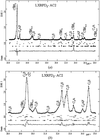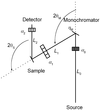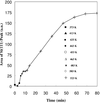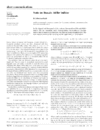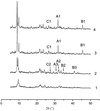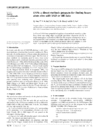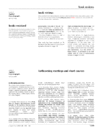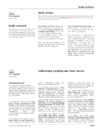issue contents
October 2003 issue

Cover illustration: Protein crystals in a 2 µl gelled microbatch drop dispensed automatically under oil. Courtesy of A. Moreno, E. Saridakis & N. E. Chayen [J. Appl. Cryst. (2002), 35, 140-142].
research papers
An efficient method to calculate the theoretical diffraction peak profiles from spherical crystallites with lognormal size distribution is presented. The intrinsic diffraction peak profiles of SiC powder, obtained by a whole-pattern deconvolution method, have shown `super-Lorentzian' shape, which can be well reproduced by the theoretical profile for the logarithmic standard deviation of the size distribution ω = 0.93.
An algorithmic procedure is proposed to infer the multimeric state of a water-soluble protein from contacts between its polypeptide chains observed in the crystal.
A new algorithm for full-pattern fitting for energy-dispersive X-ray diffraction is described, considering the errors in measuring the energy and diffraction angle, and also the fluorescence peaks. A lognormal function is introduced to represent the strong background.
As models for highly concentrated biological and other colloidal systems, computer simulations using Monte Carlo methods are used to study two bidisperse systems of spheres, one system consisting of mixtures of hard spheres and the other consisting of mixtures of hard spheres and spheres having an additional repulsive potential.
The residual stress depth distribution of hard-turned tool steel has been measured by X-ray diffraction using an integral method, which allows the determination of the stress gradient tensors in the tangential, radial and depth directions.
X-ray diffraction in Bragg geometry was used to investigate the effects of longitudinal standing waves on an Si(111) wafer, constructing a PZT/Si(111) stack with a resonant frequency of 2.34 MHz. In addition to the ultrasonic vibration, a thermal effect is evident, which has been mostly ignored or avoided in previous reports.
Whole-profile-fitting least-squares techniques are successfully applied to simulated and experimental diffraction patterns of monatomic f.c.c.-derived non-crystallographic nanoclusters, with the aim of extracting information about structure-type concentration, size and strain distribution.
Results of in situ tensile stress measurements on austenitic and ferritic steel specimens using the pulsed neutron transmission method are reported. The results show that the transmission method can be used to determine residual and applied stresses, as well as to resolve the effects of elastic anisotropy.
The accuracy in Rietveld quantitative mineralogical analyses of artificial standard Portland cement mixtures using laboratory X-ray powder diffraction has been assessed employing high-energy synchrotron X-ray powder diffraction.
Following previous works on data interpretation in the case of a one-dimensionally encoded spin-echo small-angle neutron scattering instrument when the scattering data are collected along a single direction, further studies for the more general case of data collection in two dimensions are presented.
Resonant scattering can produce considerable contrast in samples presenting a neighboring-element problem, enabling the precise determination of site occupancies. However, the accuracy of the site occupancies depends upon the data collection and analysis strategy that is adopted.
A method for estimation of chord length distributions from small-angle scattering data using indirect Fourier transformation is suggested. Examples are given using simulated data.
The twinning of La0.95Sr0.05Ga0.9Mg0.1O2.92 perovskite-type crystals has been studied using the technique of white-beam X-ray microdiffraction. The dominant twin system is formed by the intersection of domain walls (12 ) and (10
) and (10 ) in the crystal.
) in the crystal.
Scan profiles for neutron spectrometers using Gaussian-profile beam elements are derived using acceptance diagrams and agree with accepted results.
An analytic comparison of the scan profiles and peak intensity for conventional and reflecting Soller neutron collimators is reported.
Numerical tests using McSTAS show that reflecting neutron collimators, if used correctly, more than double peak intensity on powder diffractometers with no resolution cost. The tests confirm the validity of the acceptance-diagram method and the results should apply to similar devices for X-ray or electron scattering.
The analysis of Renninger scans of Mn3+-doped KDP crystals is consistent with the presence of the impurity species chemically bound within the KDP crystal structure, as confirmed through the suppression of the huge observed peak asymmetry, characteristic of perfect crystals. In addition, an extra Renninger-scan peak measured for the doped material is indicative of the impurity atoms occupying interstitial crystallographic sites in the lattice, a result consistent with X-ray standing-wave measurements.
The crystallization behaviour of aluminium-capped α-Si:H was monitored using the 111 silicon peak as a function of annealing temperature between 273 and 523 K. The results show that aluminium-induced crystallization of α-Si:H initiates at a temperature between 413 and 423 K, with crystallization rate increasing with increasing temperature and saturating for an anneal of 30 min at a temperature of 523 K.
The complete description of the texture of a polycrystalline material requires three orientational and three space coordinates. Using high-energy synchrotron radiation together with a moving-area-detector technique various two-dimensional sections and projections of this six-dimensional space can be continuously imaged, which, in grain-resolved textures, provides the complete orientation stereology of the polycrystalline material.
It is shown that in the presence of distorted subsurface layers, the occurrence of reflection structures (fine lines) depends on the divergence and monochromaticity of the incident beam, as well as on the absorption and character of X-ray scattering on distorted layers and in the main bulk (perfect part) of the crystal.
A simulation study of the performance of a converging multichannel collimator for small-angle neutron scattering reveals the effect of the incident neutron beam divergence on the transmission of individual channels.
The practical implementation of a converging multichannel collimator with discontinuous walls for use in small-angle neutron scattering instruments is reported.
short communications
Readers are reminded of the meaning and applicability of four-membered zone indices.
The formation of two kinds of mixed crystals of MgCl2 and NaCl, by ball milling magnesium chloride–ethanol adducts together with sodium chloride, is described.
computer programs
SAPI is a CCP4-format program that applies a direct-methods procedure to find heavy-atom sites using single-wavelength anomalous dispersion or single-isomorphous replacement data.
A Wintel-based menu-driven program suite PRIMUS allows the user to perform major tasks of one-dimensional small-angle scattering data processing and analysis.
The program OLEX provides tools for the visualization and topological analysis of extended network structures, as well as allowing more conventional representations.
CIF applications
Free 

The pdCIFplot program for inspecting Rietveld refinement fits reported in pdCIF files is presented.
Free 

The program CIFEDIT, which is used for the review and editing of CIFs, is described.
Free 

The program GSAS2CIF for the creation of pdCIFs from GSAS is described.
laboratory notes
Cross polarization microscopy or Hoffman modulation contrast microscopy allows the detection of colorless microcrystals grown in a matrix of lipidic cubic phase.
A quick and gentle method for mounting of crystals in capillaries is presented.
books received
Free 

Free 



 journal menu
journal menu


















